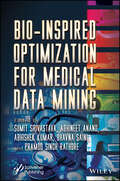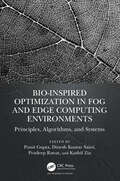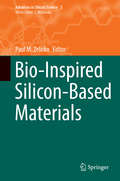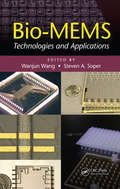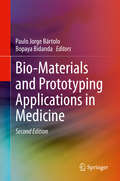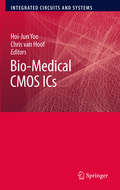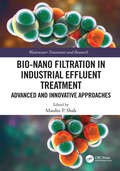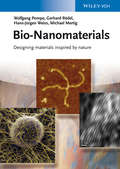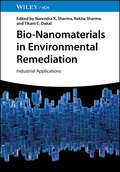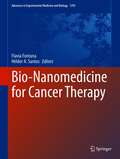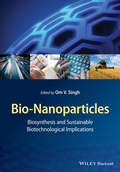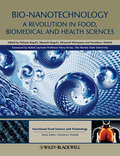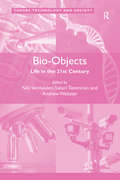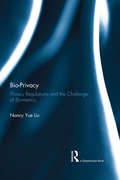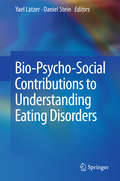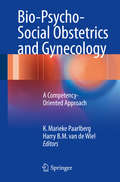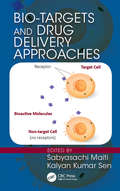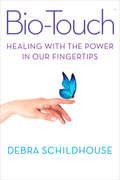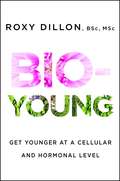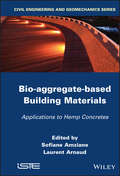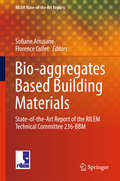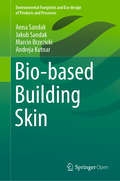- Table View
- List View
Bio-Inspired Optimization for Medical Data Mining
by Abhishek Kumar Sumit Srivastava Pramod Singh Rathore Abhineet Anand Bhavna SainiThis book is a comprehensive exploration of bio-inspired optimization techniques and their potential applications in healthcare. Bio-Inspired Optimization for Medical Data Mining is a groundbreaking book that delves into the convergence of nature’s ingenious algorithms and cutting-edge healthcare technology. Through a comprehensive exploration of state-of-the-art algorithms and practical case studies, readers gain unparalleled insights into optimizing medical data processing, enabling more precise diagnosis, optimizing treatment plans, and ultimately advancing the field of healthcare. Organized into 15 chapters, readers learn about the theoretical foundation of pragmatic implementation strategies and actionable advice. In addition, it addresses current developments in molecular subtyping and how they can enhance clinical care. By bridging the gap between cutting-edge technology and critical healthcare challenges, this book is a pivotal contribution, providing a roadmap for leveraging nature-inspired algorithms. In this book, the reader will discover Cutting-edge bio-inspired algorithms designed to optimize medical data processing, providing efficient and accurate solutions for complex healthcare challenges; How bio-inspired optimization can fine-tune diagnostic accuracy, leading to better patient outcomes and improved medical decision-making; How bio-inspired optimization propels healthcare into a new era, unlocking transformative solutions for medical data analysis; Practical insights and actionable advice on implementing bio-inspired optimization techniques and equipping effective real-world medical data scenarios; Compelling case studies illustrating how bio-inspired optimization has made a significant impact in the medical field, inspiring similar success stories. Audience This book is designed for a wide-ranging audience, including medical professionals, healthcare researchers, data scientists, and technology enthusiasts.
Bio-Inspired Optimization in Fog and Edge Computing Environments: Principles, Algorithms, and Systems
by Punit Gupta Dinesh Kumar Saini Pradeep Singh Rawat Kashif ZiaA new era of complexity science is emerging, in which nature- and bio-inspired principles are being applied to provide solutions. At the same time, the complexity of systems is increasing due to such models like the Internet of Things (IoT) and fog computing. Will complexity science, applying the principles of nature, be able to tackle the challenges posed by highly complex networked systems? Bio-Inspired Optimization in Fog and Edge Computing: Principles, Algorithms, and Systems is an attempt to answer this question. It presents innovative, bio-inspired solutions for fog and edge computing and highlights the role of machine learning and informatics. Nature- or biological-inspired techniques are successful tools to understand and analyze a collective behavior. As this book demonstrates, algorithms, and mechanisms of self-organization of complex natural systems have been used to solve optimization problems, particularly in complex systems that are adaptive, ever-evolving, and distributed in nature. The chapters look at ways of enhancingto enhance the performance of fog networks in real-world applications using nature-based optimization techniques. They discuss challenges and provide solutions to the concerns of security, privacy, and power consumption in cloud data center nodes and fog computing networks. The book also examines how: The existing fog and edge architecture is used to provide solutions to future challenges. A geographical information system (GIS) can be used with fog computing to help users in an urban region access prime healthcare. An optimization framework helps in cloud resource management. Fog computing can improve the quality, quantity, long-term viability, and cost-effectiveness in agricultural production. Virtualization can support fog computing, increase resources to be allocated, and be applied to different network layers. The combination of fog computing and IoT or cloud computing can help healthcare workers predict and analyze diseases in patients.
Bio-Inspired Silicon-Based Materials (Advances in Silicon Science #5)
by Paul M. ZeliskoThe contributed volume addresses a wide range of topics including, but not limited to, biotechnology, synthetic chemistry, polymer chemistry and materials chemistry. The book will serve as a specialized review of the field of biologically inspired silicon-based structures. Researchers studying biologically inspired silicon materials chemistry will find this volume invaluable.
Bio-MEMS: Technologies and Applications
by Wanjun Wang Steven A. SoperThis book considers both the unique characteristics of biological samples and the challenges of microscale engineering. Divided into three main sections, it first examines fabrication technologies using non-silicon processes, which are suitable for the materials more commonly used in medical/biological analyses. These include UV lithography, LIGA, nanoimprinting, and hot embossing. Attention then shifts to microfluidic components and sensing technologies for sample preparation, delivery, and analysis in microchannels and microchambers. The final section outlines various applications and systems at the leading edge of Bio-MEMS technology in a variety of areas such as drug delivery and proteomics.
Bio-Materials and Prototyping Applications in Medicine
by Paulo Jorge Bártolo Bopaya BidandaRapid prototyping is used to design and develop medical devices and instrumentation. This book details research in rapid prototyping of bio-materials for medical applications. It provides a wide variety of examples of medical applications using rapid prototyping, including tissue engineering, dental applications, and bone replacement. Coverage also discusses the emergence of computer aided design in the development of prosthetic devices.
Bio-Medical CMOS ICs (Integrated Circuits and Systems)
by Hoi-Jun Yoo Chris Van HoofThis book is based on a graduate course entitled, Ubiquitous Healthcare Circuits and Systems, that was given by one of the editors at his university. It includes an introduction and overview to the field of biomedical ICs and provides information on the current trends in research. The material focuses on the design of biomedical ICs rather than focusing on how to use prepared ICs.
Bio-Mimetic Swimmers in Incompressible Fluids: Modeling, Well-Posedness, and Controllability (Advances in Mathematical Fluid Mechanics)
by Alexander KhapalovThis monograph presents an original, concise mathematical theory for bio-mimetic swimmers in the framework of a coupled system of PDEs and ODEs. The authoritative research pioneered by the author serves as the basis for the method adopted here. This unique methodology consists of an original modelling approach, well-posedness results for the proposed models for swimmers, and a controllability theory that studies the steering potential of the proposed swimmers. A combination of this sort does not currently exist in the literature, making this an indispensable resource. Structured in five parts, the author establishes the main modeling approach in Part One. Part Two then presents the well-posedness results for these models. Parts Three through Five serve to develop a controllability theory for the swimmers, which are conceived of as artificial mechanical devices that imitate the swimming motion of fish, eels, frogs, and other aquatic creatures in nature. Several illustrative examples are provided in the last portion that serve as potential research topics. Bio-Mimetic Swimmers in Incompressible Fluids will appeal to graduate students and researchers studying fluid dynamics and control theory, as well as engineers interested in these areas.
Bio-Nano Filtration in Industrial Effluent Treatment: Advanced and Innovative Approaches (Wastewater Treatment and Research)
by Maulin P. ShahThe ever-increasing number of pollutants discharged into the environment drives the search for new treatment technologies or the modification of the existing ones. In this sense, innovation in bio-nano filtration systems seems very promising and, therefore, a book on the current advances and innovations on this topic is highly appropriate. Bio-nano filtration is a relatively new emerging technology applied to the treatment of wastewater and other toxic compounds. In the last two decades, this technology has begun to emerge as an economically viable process to treat the great variety of recalcitrant pollutants discharged into the environment. Thus, it is speculated that the US biofiltration market will reach over $100 million by 2020. This book aims to present how innovation in bio-nano filtration can provide effective solutions to overcome the serious problem of water pollution worldwide. The removal of contaminants will be the result of the combined effects of biological oxidation, adsorption, and filtration processes. Features: Describes the microbial ecology of bio-nano filtration. Describes the modelling of bio-nano filtration. Describes the design of bio-nanofillers.
Bio-Nano Interface: Applications in Food, Healthcare and Sustainability
by Manoranjan Arakha Suman Jha Arun Kumar PradhanThis book discusses the unique interactions of nanoparticles with various biomolecules under different environmental conditions. It describes the consequences of these interactions on other biological aspects like flora and fauna of the niche, cell proliferation, etc. The book provides information about the novel and eco-friendly nanoparticle synthesis methods, such as continuous synthesis of nanoparticles using microbial cells. Additionally, the book discusses nanoparticles' potential impact in different areas of biological sciences like food, medicine, agriculture, and the environment. Due to their advanced physicochemical properties, nanoparticles have revolutionized biomedical and pharmaceutical sciences. Inside the biological milieu, nanoparticles interact with different moieties to adopt stable shape, size, and surface functionalities and form nano-biomolecular complexes. The interaction pattern at the interface form complexes determines the fate of interacting biomolecules and nanoparticles inside the biological system. Understanding the interaction pattern at the nano-bio interface is crucial for the safe use of nanoparticles in natural sciences. This book rightly addresses all questions about the interaction and the ensuing structure and function of these nano-biomolecular complexes. This book caters to students and researchers in the area of biotechnology, microbiology, and pharmaceutical sciences.
Bio-Nanomaterials
by Hans-Jürgen Weiss Wolfgang Pompe Michael Mertig Gerhard RödelBio-nanotechnology covers the development of novel techniques and materials by making use ofthe inspiration derived from biomolecular structures and processes. The progress in molecular biology and microbiology over the past 50 years has provided a solid basis for such development.Well characterized natural biomolecules as well as tailored recombinant proteins and tailored microorganisms obtained by genetic engineering provide a large "toolbox" for the implementation ofbiological structures in a technical environment. Biologically inspired materials engineering enables,for example, the preparation of living tissue for regenerative bone therapy and the biologicallycontrolled mineralization of precious metal catalysts via immobilized microorganisms.Written by authors from different fields to reflect the interdisciplinary nature of the topic, thisbook guides the reader through novel nano-materials processing inspired by nature. The presentationis structured around general principles in seven chapters, each composed of three parts:(1) biological case studies providing the motivation, (2) elucidation of the particular principle,(3) applications related to materials processing.
Bio-Nanomaterials in Environmental Remediation: Industrial Applications
by Rekha Sharma Narendra K. Sharma Tikam C. DakalReference on using bio-nanomaterials to remove pollution in industrial sectors ranging from food and agriculture to oil and gas Bio-Nanomaterials in Environmental Remediation discusses the application of bio-nanomaterials in various industrial settings. Bio-Nanomaterials in Environmental Remediation includes information on: Fundamentals, classification, and applications of bio-nanomaterials, technologies for the fabrication of bio-nanomaterials, and desalination of wastewater using bio-nanomaterials Applications of bio-nanomaterials in the textiles, oil, gas, food, and agriculture industries Hazard, toxicity, and monitoring standards of bio-nanomaterials Current challenges of bio-nanomaterials in industrial applications and future outlooks in the field Strategies to manage the safety of bio-nanomaterials to enable the creation of healthy and pollution-free environments Bio-Nanomaterials in Environmental Remediation is an essential up-to-date reference for professionals, researchers, and scientists working in fields where bio-nanomaterials are used.
Bio-Nanomedicine for Cancer Therapy (Advances in Experimental Medicine and Biology #1295)
by Flavia Fontana Hélder A. SantosThe book covers the latest developments in biologically-inspired and derived nanomedicine for cancer therapy. The purpose of the book is to illustrate the significance of naturally-mimicking systems for enhancing the dose delivered to the tumor, to improve stability, and prolong the circulation time. Moreover, readers are presented with advanced materials such as adjuvants for immunostimulation in cancer vaccines. The book also provides a comprehensive overview of the current status of academic research. This is an ideal book for students, researchers, and professors working in nanotechnology, cancer, targeted drug delivery, controlled drug release, materials science, and biomaterials as well as companies developing cancer immunotherapy.
Bio-Nanoparticles
by Om V. SinghNanoparticles are considered to be the building blocks for nanotechnology and are referred to as the particles having more than one dimension of the order of 100 nm or less.The nanostructured materials are being offered as better built, long lasting, cleaner, safer, and smarter products for use in communications, medicine, transportation, agriculture and other industries. Topics in molecular recognition, biomolecule-nanocrystal conjugates as fluorescence label for biological cells, and DNA-mediated groupings of nanocrystals are widespread, intriguing researchers from both biological and engineering fields. The diversity of nanotechnology covers fields from biology to material science, physics to chemistry, and other fields with variety of specialties. Controlled size, shape, composition, crystallinity, and structure-dependent properties of nanoparticles govern the unique properties of nanotechnology. The controlled biosynthesis of nanoparticles is of high scientific and technological interest as the microorganisms grab target ions from their environment and then turn the metal ions into the element metal through enzymatic mechanism generated through their cellular (Intra/ Extra) activities. The project aims to introduce the basics and advancements made so far in the field of biosynthesis of nanoparticles for graduate students and researchers around the world. The main aims are to (a) introduce the reader to the variety of microorganisms and their ability to synthesize the nanoparticles, (b) provide an overview of the methodologies applied to biosynthesize the variety of nanoparticles of medical and commercial uses, (c) provide a literature review on diversity of microorganisms able to synthesize nanoparticles of different types, (d) to discuss the regulatory mechanisms in microorganism able to synthesize variety of nanoparticles, (e) discuss experimental design problems associated with the controlled biosynthesis of nanoparticles, (f) discuss the stability and toxicity of nanoparticles in varying environment towards their therapeutic implications. The regulations, challenges and implications of biosynthesized nanoparticles for commercial significance will also represent among the main sections of the book. These aims will be organized by invited research/ review articles from renowned researchers exploring biosynthesis of variety of nanoparticles, and differ in length and number of chapters, with the literature review section containing the bulk of the text.
Bio-Nanotechnology: A Revolution in Food, Biomedical and Health Sciences (Hui: Food Science and Technology #11)
by Fereidoon Shahidi Manashi Bagchi Hiroyoshi MoriyamaBio-nanotechnology is the key functional technology of the 21st century. It is a fusion of biology and nanotechnology based on the principles and chemical pathways of living organisms, and refers to the functional applications of biomolecules in nanotechnology. It encompasses the study, creation, and illumination of the connections between structural molecular biology, nutrition and nanotechnology, since the development of techniques of nanotechnology might be guided by studying the structure and function of the natural nano-molecules found in living cells. Biology offers a window into the most sophisticated collection of functional nanostructures that exists. This book is a comprehensive review of the state of the art in bio-nanotechnology with an emphasis on the diverse applications in food and nutrition sciences, biomedicine, agriculture and other fields. It describes in detail the currently available methods and contains numerous references to the primary literature, making this the perfect “field guide” for scientists who want to explore the fascinating world of bio-nanotechnology. Safety issues regarding these new technologies are examined in detail. The book is divided into nine sections – an introductory section, plus: Nanotechnology in nutrition and medicine Nanotechnology, health and food technology applications Nanotechnology and other versatile applications Nanomaterial manufacturing Applications of microscopy and magnetic resonance in nanotechnology Applications in enhancing bioavailability and controlling pathogens Safety, toxicology and regulatory aspects Future directions of bio-nanotechnology The book will be of interest to a diverse range of readers in industry, research and academia, including biologists, biochemists, food scientists, nutritionists and health professionals.
Bio-Objects: Life in the 21st Century (Theory, Technology and Society)
by Andrew Webster Sakari Tamminen Niki VermeulenIncreasing knowledge of the biological is fundamentally transforming what life itself means and where its boundaries lie. New developments in the biosciences - especially through the molecularisation of life - are (re)shaping healthcare and other aspects of our society. This cutting edge volume studies contemporary bio-objects, or the categories, materialities and processes that are central to the configuring of 'life' today, as they emerge, stabilize and circulate through society. Examining a variety of bio-objects in contexts beyond the laboratory, Bio-Objects: Life in the 21st Century explores new ways of thinking about how novel bio-objects enter contemporary life, analysing the manner in which, among others, the boundaries between human and animal, organic and non-organic, and being 'alive' and the suspension of living, are questioned, destabilised and in some cases re-established. Thematically organised around questions of changing boundaries; the governance and regulation of bio-objects; and changing social, economic and political relations, this book presents rich new case studies from Europe that will be of interest to scholars of science and technology studies, social theory, sociology and law.
Bio-Privacy: Privacy Regulations and the Challenge of Biometrics
by Nancy Yue LiuBio-Privacy: Privacy Regulations and the Challenge of Biometrics provides an in-depth consideration of the legal issues posed by the use of biometric technology. Focusing particularly on the relationship between the use of this technology and the protection of privacy, this book draws on material across a range of jurisdictions in order to explore several key questions. What are the privacy issues in the biometric context? How are these issues currently dealt with under the law? What principles are applied? Is the current regulation satisfactory? Is it applied consistently? And, more generally, what is the most appropriate way to deal with the legal implications of biometrics? Offering an analysis, and recommendations, with a view to securing adequate human rights and personal data protection, Bio-Privacy: Privacy Regulations and the Challenge of Biometrics will be an important reference point for those with interests in the tension between freedom and security.
Bio-Psycho-Social Contributions to Understanding Eating Disorders
by Daniel Stein Yael LatzerThis book uniquely combines cutting-edge medical, psychological, and sociocultural topics pertinent to eating disorders. In the medical realm, the book focuses on Eating Disorders' newly investigated associations with ADHD and sleep disorders, and on innovative treatments of osteoporosis in anorexia nervosa. Novel contributions in the psychological realm address families' trans-generational transmission of Eating Disorders-related difficulties and novel internet-based treatments for such families. Lastly, in the sociocultural realm, the book discusses social contagion and Pro-Ana websites as increasing risk for disordered eating in young women around the globe. This volume provides readers with more holistic perspectives of each realm and their interplay, to promote Eating Disorders' understanding, treatment, prevention, and research. It provides various professionals including mental health providers, physicians, nutritionists, and graduate students in these professions.
Bio-Psycho-Social Obstetrics and Gynecology: A Competency-Oriented Approach
by K Marieke Paarlberg Harry B.M. van de WielThis book will assist the reader by providing individually tailored, high-quality bio-psycho-social care to patients with a wide range of problems within the fields of obstetrics, gynaecology, fertility, oncology, and sexology. Each chapter addresses a particular theme, issue, or situation in a problem-oriented and case-based manner that emphasizes the differences between routine and bio-psycho-social care. Relevant facts and figures are presented, advice is provided regarding the medical, psychological, and caring process, and contextual aspects are discussed. The book offers practical tips and actions within the bio-psycho-social approach, and highlights important do's and don'ts. To avoid a strict somatic thinking pattern, the importance of communication, multidisciplinary collaboration, and creation of a working alliance with the patient is emphasized. The book follows a consistent format, designed to meet the needs of challenged clinicians.
Bio-Targets and Drug Delivery Approaches
by Sabyasachi Maiti and Kalyan Kumar SenThe advances in drug delivery systems over recent years have resulted in a large number of novel delivery systems with the potential to revolutionize the treatment and prevention of diseases. Bio-Targets and Drug Delivery Approaches is an easy-to-read book for students, researchers and pharmaceutical scientists providing a comprehensive introduction to the principles of advanced drug delivery and targeting their current applications and potential future developments.
Bio-Touch
by Debra SchildhouseWith just two fingers from each hand, the healing process can begin. Bio-Touch: Healing with the Power in Our Fingertips is the story of the scientifically-proven, touch-based healing technique proven to alleviate pain, stress, the symptoms of disease, and depression. Debra Schildhouse, an initial skeptic, is drawn to Bio-Touch after feeling helpless to do anything for her daughter's agonizing headaches from viral meningitis. Her search for a method to heal other's physical pain gradually becomes an inner journey of personal healing as she opens her mind, expands her self-awareness, and eventually becomes a certified instructor and practitioner of Bio-Touch. In tandem with her own story, Schildhouse recounts Bio-Touch founder Paul Bucky's story, following the many twists and turns his spiritual path takes him from childhood to adulthood and finally to the discovery of Bio-Touch. Throughout the narrative Schildhouse relates miraculous stories of healing. Touching and often funny, Bio-Touch draws together the many invisible bonds of the universe linking us all together. BIO-TOUCH is made up of seventeen sets of points, each designed to address a particular condition by encouraging the body's natural healing abilities. It is a complimentary therapy that can be used in conjunction with mainstream medicine. Ability to pay is not a criterion for receiving sessions and it is easy to learn - no special talents or beliefs are required. Bio-Touch comes with several diagrams illustrating how to find correct - touch points - on the body.
Bio-Touch: Healing with the Power In Our Fingertips
by Gary E. Schwartz Debra SchildhouseWith just two fingers from each hand, the healing process can begin. Bio-Touch: Healing with the Power in Our Fingertips is the story of the scientifically-proven, touch-based healing technique proven to alleviate pain, stress, the symptoms of disease, and depression. Debra Schildhouse, an initial skeptic, is drawn to Bio-Touch after feeling helpless to do anything for her daughter's agonizing headaches from a mysterious illness. Her search for a method to heal others' pain gradually becomes an inner journey of personal healing as she opens her mind and eventually becomes a certified instructor and practitioner of Bio-Touch. In tandem with her own story, Schildhouse recounts Bio-Touch founder Paul Bucky's journey as he follows his spiritual path to the discovery of Bio-Touch. Throughout the narrative Schildhouse relates miraculous stories of healing. Touching and often funny, Bio-Touch draws together the many invisible bonds of the universe linking us all together.
Bio-Young
by Roxy DillonA groundbreaking, easy-to-follow, all-natural anti-aging program using vitamins, natural oils, and many common foods that will help you to look and feel younger.You've always heard that "age is just a number"--now Roxy Dillon, the Youth Guru, has the science to prove it. Those wrinkles under your eyes are not simply an inevitable part of the aging process. Actually, those unpleasant surprises in the mirror are a result of the decline in your cellular and hormonal functions. Science shows us that your hormones quickly decline after age thirty, leading to a variety of changes in your body including hair loss, saggy skin, and unwanted facial hair. The good news is that all of your aging symptoms can be halted--and even reversed. In Bio-Young, renowned anti-aging expert Roxy Dillon guides you through an easy-to-follow regimen that will naturally stop and reverse the aging process. Amazingly, common plants and foods contain compounds that are now scientifically proven to stimulate cellular and hormonal function, and actually reverse aging! Using ingredients that you can find at home, you can stimulate your hormone-producing glands into youthful activity again. Discover the bio-actives--foods, herbs, supplements, edibles, and essential oils--that you should be eating, or applying externally, and learn how their key compounds (such as resveratrol in red wine, squalene in olive oil, or ferulic acid in rice bran oil) will plump your skin, reduce high blood pressure, and even fight cancer cells. From restoring thinning hair with rosemary and smoothing wrinkles with honey, to preventing grey hair with onion juice--there's a natural solution for every problem. Roxy has created a clear-cut program that will help you take control of your looks and turn back the clock. Get ready to look and feel years younger!
Bio-aggregate-based Building Materials: Applications to Hemp Concretes (Rilem State-of-the-art Reports #23)
by Laurent Arnaud Sofiane AmzianeUsing plant material as raw materials for construction is a relatively recent and original topic of research. This book presents an overview of the current knowledge on the material properties and environmental impact of construction materials made from plant particles, which are renewable, recyclable and easily available. It focuses on particles and as well on fibers issued from hemp plant, as well as discussing hemp concretes. The book begins by setting the environmental, economic and social context of agro-concretes, before discussing the nature of plant-based aggregates and binders. The formulation, implementation and mechanical behavior of such building materials are the subject of the following chapters. The focus is then put upon the hygrothermal behavior and acoustical properties of hempcrete, followed by the use of plant-based concretes in structures. The book concludes with the study of life-cycle analysis (LCA) of the environmental characteristics of a banked hempcrete wall on a wooden skeleton. Contents 1. Environmental, Economic and Social Context of Agro-Concretes, Vincent Nozahic and Sofiane Amziane. 2. Characterization of Plant-Based Aggregates. Vincent Picandet. 3. Binders, Gilles Escadeillas, Camille Magniont, Sofiane Amziane and Vincent Nozahic. 4. Formulation and Implementation, Christophe Lanos, Florence Collet, Gérard Lenain and Yves Hustache. 5. Mechanical Behavior, Laurent Arnaud, Sofiane Amziane, Vincent Nozahic and Etienne Gourlay. 6. Hygrothermal Behavior of Hempcrete, Laurent Arnaud, Driss Samri and Étienne Gourlay. 7. Acoustical Properties of Hemp Concretes, Philippe Glé, Emmanuel Gourdon and Laurent Arnaud. 8. Plant-Based Concretes in Structures: Structural Aspect – Addition of a Wooden Support to Absorb the Strain, Philippe Munoz and Didier Pipet. 9. Examination of the Environmental Characteristics of a Banked Hempcrete Wall on a Wooden Skeleton, by Lifecycle Analysis: Feedback on the LCA Experiment from 2005, Marie-Pierre Boutin and Cyril Flamin. About the Authors Sofiane Amziane is Professor and head of the Civil Engineering department at POLYTECH Clermont-Ferrand in France. He is also in charge of the research program dealing with bio-based building materials at Blaise Pascal University (Institut Pascal, Clermont Ferrand, France). He is the secretary of the RILEM Technical Committee 236-BBM dealing with bio-based building materials and the author or co-author of over one hundred papers in scientific journals such as Cement and Concrete Research, Composite Structures or Construction Building Materials as well as international conferences. Laurent Arnaud is a Bridges, Waters and Forestry Engineer (Ingénieur des Ponts, Eaux et Forêts) and researcher at Joseph Fourier University in Grenoble, France. He is also Professor at ENTPE (Ecole Nationale des Travaux Publics de l’Etat). Trained in the field of mechanical engineering, his research has been directed toward the characterization and development of new materials for civil engineering and construction. He is head of the international committee at RILEM – BBM, as well as the author of more than one hundred publications, and holder of an international invention patent.
Bio-aggregates Based Building Materials: State-of-the-Art Report of the RILEM Technical Committee 236-BBM (RILEM State-of-the-Art Reports #23)
by Sofiane Amziane Florence ColletUsing plant material as raw materials for construction is a relatively recent and original topic of research. This book presents an overview of the current knowledge on the material properties and environmental impact of construction materials made from plant particles, which are renewable, recyclable and easily available. It focuses on particles and as well on fibers issued from hemp plant, as well as discussing hemp concretes. The book begins by setting the environmental, economic and social context of agro-concretes, before discussing the nature of plant-based aggregates and binders. The formulation, implementation and mechanical behavior of such building materials are the subject of the following chapters. The focus is then put upon the hygrothermal behavior and acoustical properties of hempcrete, followed by the use of plant-based concretes in structures. The book concludes with the study of life-cycle analysis (LCA) of the environmental characteristics of a banked hempcrete wall on a wooden skeleton. Contents 1. Environmental, Economic and Social Context of Agro-Concretes, Vincent Nozahic and Sofiane Amziane. 2. Characterization of Plant-Based Aggregates. Vincent Picandet. 3. Binders, Gilles Escadeillas, Camille Magniont, Sofiane Amziane and Vincent Nozahic. 4. Formulation and Implementation, Christophe Lanos, Florence Collet, G#65533;rard Lenain and Yves Hustache. 5. Mechanical Behavior, Laurent Arnaud, Sofiane Amziane, Vincent Nozahic and Etienne Gourlay. 6. Hygrothermal Behavior of Hempcrete, Laurent Arnaud, Driss Samri and #65533;tienne Gourlay. 7. Acoustical Properties of Hemp Concretes, Philippe Gl#65533;, Emmanuel Gourdon and Laurent Arnaud. 8. Plant-Based Concretes in Structures: Structural Aspect - Addition of a Wooden Support to Absorb the Strain, Philippe Munoz and Didier Pipet. 9. Examination of the Environmental Characteristics of a Banked Hempcrete Wall on a Wooden Skeleton, by Lifecycle Analysis: Feedback on the LCA Experiment from 2005, Marie-Pierre Boutin and Cyril Flamin. About the Authors Sofiane Amziane is Professor and head of the Civil Engineering department at POLYTECH Clermont-Ferrand in France. He is also in charge of the research program dealing with bio-based building materials at Blaise Pascal University (Institut Pascal, Clermont Ferrand, France). He is the secretary of the RILEM Technical Committee 236-BBM dealing with bio-based building materials and the author or co-author of over one hundred papers in scientific journals such as Cement and Concrete Research, Composite Structures or Construction Building Materials as well as international conferences. Laurent Arnaud is a Bridges, Waters and Forestry Engineer (Ing#65533;nieur des Ponts, Eaux et For#65533;ts) and researcher at Joseph Fourier University in Grenoble, France. He is also Professor at ENTPE (Ecole Nationale des Travaux Publics de l'Etat). Trained in the field of mechanical engineering, his research has been directed toward the characterization and development of new materials for civil engineering and construction. He is head of the international committee at RILEM - BBM, as well as the author of more than one hundred publications, and holder of an international invention patent.
Bio-based Building Skin (Environmental Footprints and Eco-design of Products and Processes)
by Andreja Kutnar Anna Sandak Jakub Sandak Marcin BrzezickiThis book provides a compendium of material properties, demonstrates several successful examples of bio-based materials’ application in building facades, and offers ideas for new designs and novel solutions. It features a state-of-the-art review, addresses the latest trends in material selection, assembling systems, and innovative functions of facades in detail. Selected case studies on buildings from diverse locations are subsequently presented to demonstrate the successful implementation of various biomaterial solutions, which defines unique architectural styles and building functions. The structures, morphologies and aesthetic impressions related to bio-based building facades are discussed from the perspective of art and innovation; essential factors influencing the performance of materials with respect to functionality and safety are also presented. Special emphasis is placed on assessing the performance of a given facade throughout the service life of a building, and after its end. The book not only provides an excellent source of technical and scientific information, but also contributes to public awareness by demonstrating the benefits to be gained from the proper use of bio-based materials in facades. As such, it will appeal to a broad audience including architects, engineers, designers and building contractors.
